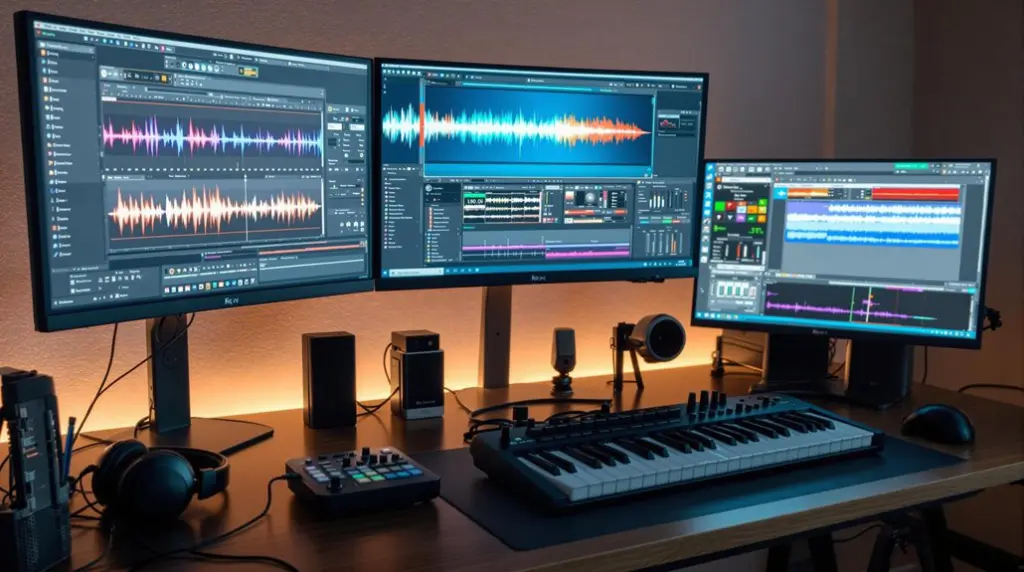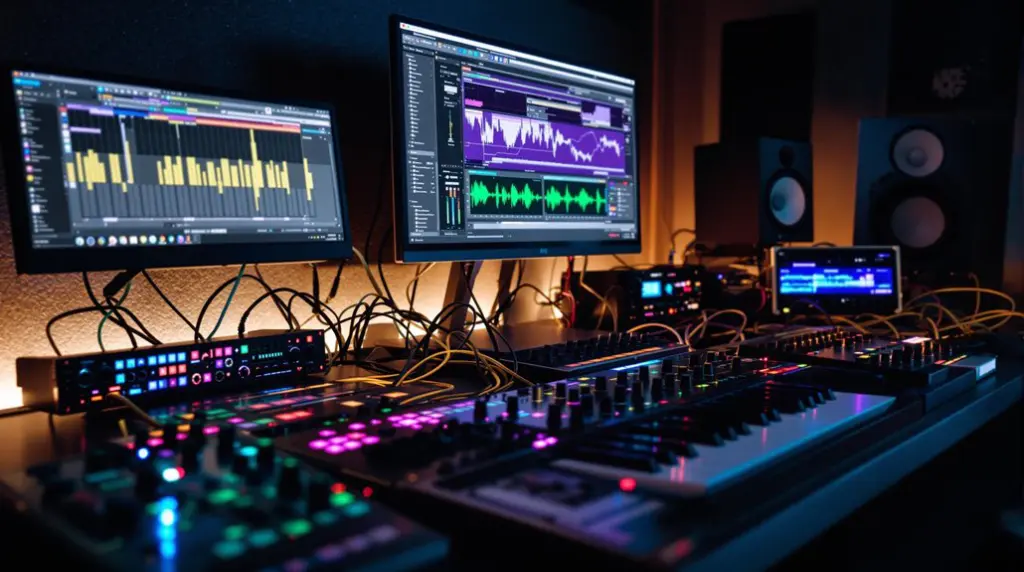Arturia SEM V2 VST plugin excels with its dual oscillators offering sawtooth and variable-width pulse waves for intricate layering, and a thorough modulation matrix featuring eight bipolar slots for extensive internal modulation. The 8-voice programmer enhances creative freedom by enabling individual programming of each voice, while integrated effects like overdrive, chorus, and delay add depth and richness to the sound. The user-friendly interface, mirroring the original Oberheim hardware, guarantees a seamless and intuitive experience with low CPU usage. Engage with these features for a profound sound design journey that reveals even more latent capabilities.
Key Takeaways
- Dual oscillators with sawtooth and variable-width pulse waves allow intricate layering and unique tonal blending.
- Eight bipolar modulation matrix slots enable complex internal routing and evolving analog sounds.
- 8-Voice Programmer offers independent filters and envelopes for each voice, enhancing polyphonic variability.
- Integrated effects include overdrive, chorus, and delay for shaping and enriching soundscapes.
- User-friendly interface replicates Oberheim hardware, ensuring high-quality audio with low CPU usage.
Dual Oscillators and Filters
In the domain of virtual synthesizers, the Arturia SEM V2’s dual oscillators and multi-mode filters stand out for their robust sound design capabilities. The dual-oscillator architecture, featuring sawtooth and variable-width pulse waves, provides a foundation for creating a vast array of sounds. Each oscillator can be tuned independently, allowing for intricate layering and sound design.
Such oscillator tuning enables users to craft unique tonal landscapes by blending different frequencies harmoniously. This flexibility is akin to layering sounds effectively, where isolating frequency ranges and combining textures can transform simple melodies into complex experiences.
The filter section of the SEM V2 is equally impressive, sporting a multi-mode 12dB/octave filter with low-pass, band-pass, notch, and high-pass options. This versatility guarantees that users can shape their sounds precisely to their requirements.
The ability to adjust filter resonance further enhances the synthesizer’s flexibility, allowing for the creation of rich, resonant tones without significant loss in output levels. This feature is particularly valuable for those seeking to add depth and character to their patches.
Additionally, the inclusion of sub-oscillation with three selectable waveforms enriches the sound below the primary oscillators, contributing to a fuller audio output.
This combination of oscillator tuning and filter resonance positions the Arturia SEM V2 as a powerful tool for both novice and experienced sound designers.
Modulation Matrix and LFOs
How does the Arturia SEM V2 enhance its synthesis capabilities? The answer lies in its sophisticated modulation matrix and versatile LFOs.
The SEM V2’s modulation matrix features eight bipolar slots, providing extensive internal modulation techniques that greatly expand sound design flexibility. Each slot allows for routing a variety of modulation sources to numerous parameters, including oscillator pitch and filter cutoff, thereby facilitating dynamic and evolving sound textures.
One of the standout features of the SEM V2 is its dual LFO system. LFO1 can be assigned independently to each voice, enabling intricate, voice-specific modulations. This independent control allows users to craft unique sound variations across different voices, enriching the overall sonic palette.
On the other hand, LFO2 operates in a monophonic mode, serving as a global modulation source that can influence multiple parameters simultaneously. This duality between independent and global modulation sources fosters both precision and cohesion in sound design.
The SEM V2’s modulation matrix encourages experimentation, allowing users to create complex routings and offsets. These capabilities promote the exploration of unconventional sound designs, enhancing the authentic analog feel that SEM V2 is renowned for.
Fundamentally, the modulation matrix and LFOs greatly contribute to the plugin’s ability to deliver rich, evolving sounds.
8-Voice Programmer
Stepping up the Arturia SEM V2‘s synthesis game, the Voice Programmer (8VP) introduces a level of intricacy that raises sound design to new heights. The 8VP enables users to operate up to 8 SEMs simultaneously in a mono setting, which is a vital feature for those seeking complex sound creation through voice layering. Each of these voices can be individually programmed, featuring independent filters and envelopes, along with 6 slots for parameter adjustments.
This architecture facilitates unparalleled sound sculpting, allowing for the crafting of unique sound textures. Functioning as a step sequencer, the 8VP permits subtle tuning adjustments across multiple voices, creating imperfections that contribute to an organic feel. Users can achieve polyphonic variability by manipulating parameters such as VCF Frequency and LFO modulation. This capability greatly enhances the richness and dimensionality of the sound output, making it ideal for sophisticated sound design.
To further enhance your mixes, consider preventing frequency masking to make sure each element stands out clearly.
The 8VP also encourages experimentation, particularly with extreme parameter values, fostering creative sound design that echoes classic analog synth characteristics. Overall, the Voice Programmer is an essential tool for users looking to push the boundaries of their sonic palette, providing a robust platform for innovative sound exploration.
Integrated Effects
With a focus on enhancing the sonic capabilities of the Arturia SEM V2, the integrated effects units—overdrive, chorus, and delay—play an essential role in shaping its distinctive sound. These effects, meticulously designed to complement the classic Oberheim tonal palette, allow for extensive effect customization and intricate sound layering.
DJs and producers often seek software that offers advanced library management, and the Arturia SEM V2’s effects guarantee that users can precisely curate their sound libraries with rich, layered tones.
The overdrive effect adds a layer of warmth and character, emulating the richness of vintage synthesizers. This effect is particularly effective in achieving a richer tonal quality that can raise the harmonic content of a sound.
The chorus effect, on the other hand, provides spatial qualities, enabling the creation of lush, immersive soundscapes that can transform a simple melody into a complex aural experience.
Finally, the delay effect introduces rhythmic patterns and echoes, considerably expanding the sonic possibilities and adding depth to the musical output.
Key Features:
- Overdrive: Adds warmth and vintage character, enhancing harmonic richness.
- Chorus: Enriches sound with spatial qualities, ideal for lush soundscapes.
- Delay: Provides rhythmic patterns and echoes, broadening sonic horizons.
Each effect is equipped with panel controls for on/off status and dry/wet ratio adjustments, allowing for precise control over effect customization and sound layering, thereby guaranteeing users achieve their desired sound design effortlessly.
User Interface and Experience
Building on the robust integrated effects that enhance the Arturia SEM V2’s sonic capabilities, the user interface and overall experience have been meticulously designed to mirror the intuitive workflow of the original Oberheim hardware.
The Arturia SEM V2 features a user-friendly interface that closely resembles the original Oberheim controls, which greatly facilitates intuitive sound design and manipulation. The central section of the interface replicates the SEM’s oscillators, multimode filter, and envelopes, allowing users to engage with familiar, yet powerful, sound-shaping tools.
Moreover, the interface includes additional controls that boost the overall functionality, such as a modulation section, key mapping area, and step sequencer. These additions enable users to create complex sounds with ease, fostering a seamless user experience.
By integrating advanced tips for enhanced noise removal, the interface guarantees that users can maintain high audio quality. The interface’s responsiveness and efficiency, even in 32-bit mode with low CPU usage, guarantee that it performs well under demanding project conditions, making it suitable for multiple instances within a single project.
Detailed documentation and tutorials further enrich the user experience by providing guidance and fostering a supportive community where users can share presets and tips for effective sound design.
This all-encompassing approach guarantees that both novice and experienced users can maximize the plugin’s potential.
Frequently Asked Questions
What Is Arturia Used For?
Arturia SEM V2 is utilized in synthesizer applications for creating rich analog sounds, ideal for electronic, ambient, and pop music. Its advanced sound design capabilities, including modulation matrix and effects, cater to both novices and seasoned sound designers.
What Is SEM Synth?
The SEM synth, introduced by Oberheim in 1974, utilizes sem synthesis through dual oscillators and a multi-mode filter. Its analog modeling provides warm, fat tones, influencing numerous synthesizers and remaining a staple in sound design across genres.
Conclusion
To summarize, the Arturia SEM V2 VST plugin offers a robust set of features, including dual oscillators and filters, a versatile modulation matrix with LFOs, an 8-voice programmer, and integrated effects. These elements collectively provide a rich and flexible sound design environment. The user interface is designed for ease of use while maintaining depth for advanced users. Overall, the SEM V2 stands out as a powerful tool for both novice and experienced electronic musicians.




